BMW Z4 3.0I COUPE 2007 E86 Manual PDF
Manufacturer: BMW, Model Year: 2007, Model line: Z4 3.0I COUPE, Model: BMW Z4 3.0I COUPE 2007 E86Pages: 132, PDF Size: 3.14 MB
Page 71 of 132
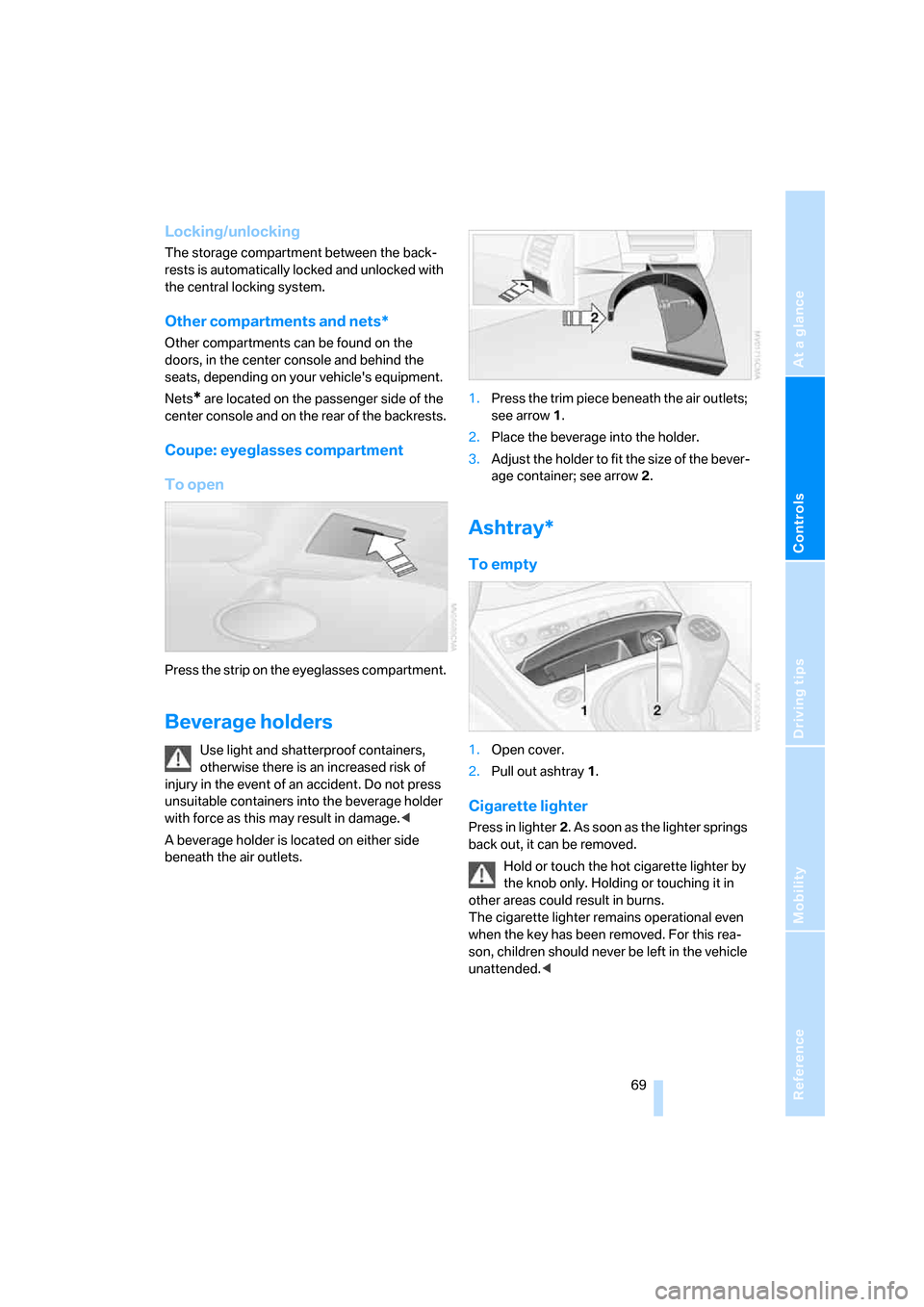
Reference
At a glance
Controls
Driving tips
Mobility
69
Locking/unlocking
The storage compartment between the back-
rests is automatically locked and unlocked with
the central locking system.
Other compartments and nets*
Other compartments can be found on the
doors, in the center console and behind the
seats, depending on your vehicle's equipment.
Nets
* are located on the passenger side of the
center console and on the rear of the backrests.
Coupe: eyeglasses compartment
To open
Press the strip on the eyeglasses compartment.
Beverage holders
Use light and shatterproof containers,
otherwise there is an increased risk of
injury in the event of an accident. Do not press
unsuitable containers into the beverage holder
with force as this may result in damage.<
A beverage holder is located on either side
beneath the air outlets.1.Press the trim piece beneath the air outlets;
see arrow1.
2.Place the beverage into the holder.
3.Adjust the holder to fit the size of the bever-
age container; see arrow2.
Ashtray*
To empty
1.Open cover.
2.Pull out ashtray1.
Cigarette lighter
Press in lighter2. As soon as the lighter springs
back out, it can be removed.
Hold or touch the hot cigarette lighter by
the knob only. Holding or touching it in
other areas could result in burns.
The cigarette lighter remains operational even
when the key has been removed. For this rea-
son, children should never be left in the vehicle
unattended.<
Page 72 of 132
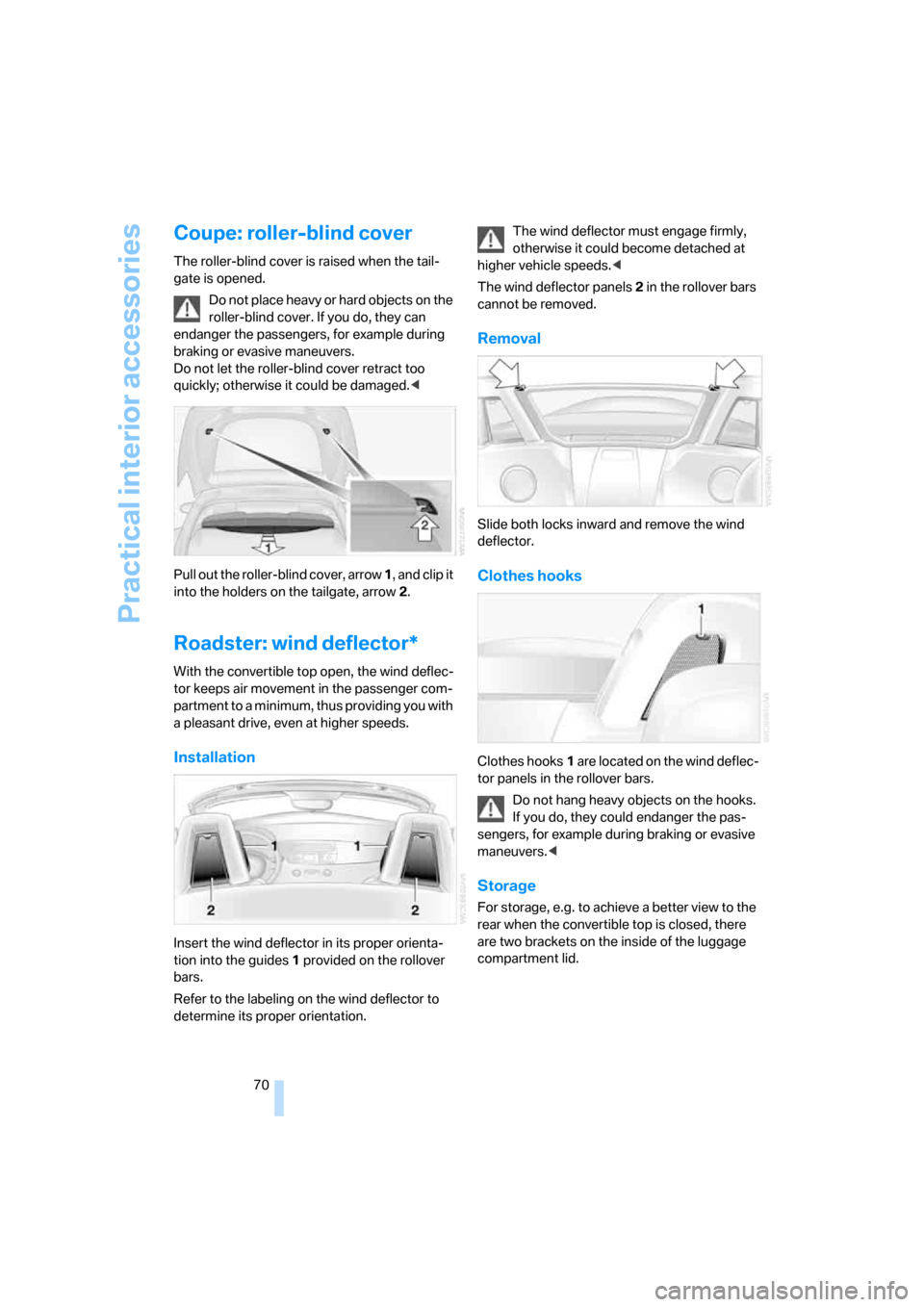
Practical interior accessories
70
Coupe: roller-blind cover
The roller-blind cover is raised when the tail-
gate is opened.
Do not place heavy or hard objects on the
roller-blind cover. If you do, they can
endanger the passengers, for example during
braking or evasive maneuvers.
Do not let the roller-blind cover retract too
quickly; otherwise it could be damaged.<
Pull out the roller-blind cover, arrow 1, and clip it
into the holders on the tailgate, arrow 2.
Roadster: wind deflector*
With the convertible top open, the wind deflec-
tor keeps air movement in the passenger com-
partment to a minimum, thus providing you with
a pleasant drive, even at higher speeds.
Installation
Insert the wind deflector in its proper orienta-
tion into the guides1 provided on the rollover
bars.
Refer to the labeling on the wind deflector to
determine its proper orientation.The wind deflector must engage firmly,
otherwise it could become detached at
higher vehicle speeds.<
The wind deflector panels2 in the rollover bars
cannot be removed.
Removal
Slide both locks inward and remove the wind
deflector.
Clothes hooks
Clothes hooks1 are located on the wind deflec-
tor panels in the rollover bars.
Do not hang heavy objects on the hooks.
If you do, they could endanger the pas-
sengers, for example during braking or evasive
maneuvers.<
Storage
For storage, e.g. to achieve a better view to the
rear when the convertible top is closed, there
are two brackets on the inside of the luggage
compartment lid.
Page 73 of 132
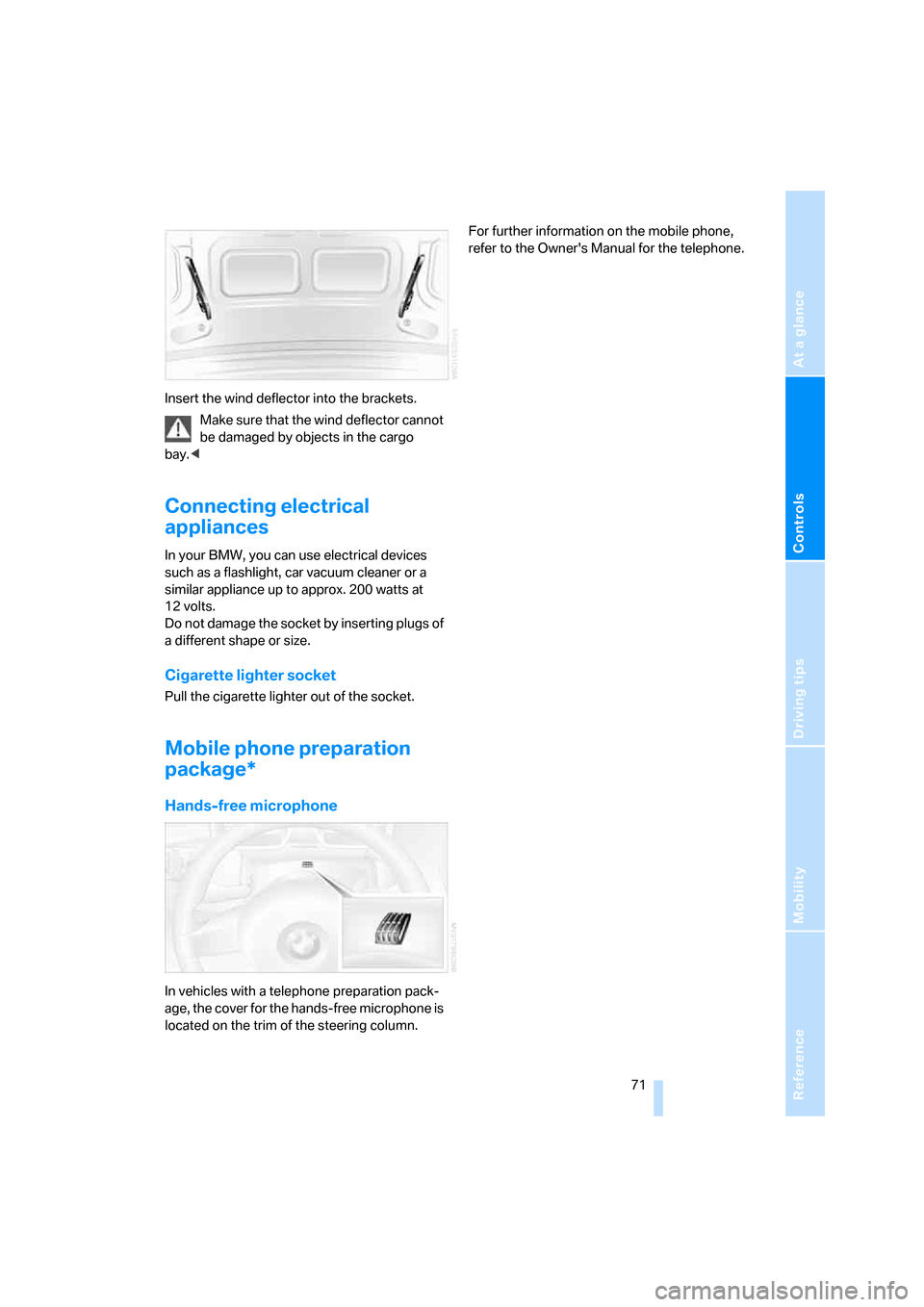
Reference
At a glance
Controls
Driving tips
Mobility
71
Insert the wind deflector into the brackets.
Make sure that the wind deflector cannot
be damaged by objects in the cargo
bay.<
Connecting electrical
appliances
In your BMW, you can use electrical devices
such as a flashlight, car vacuum cleaner or a
similar appliance up to approx. 200 watts at
12 volts.
Do not damage the socket by inserting plugs of
a different shape or size.
Cigarette lighter socket
Pull the cigarette lighter out of the socket.
Mobile phone preparation
package*
Hands-free microphone
In vehicles with a telephone preparation pack-
age, the cover for the hands-free microphone is
located on the trim of the steering column.For further information on the mobile phone,
refer to the Owner's Manual for the telephone.
Page 74 of 132
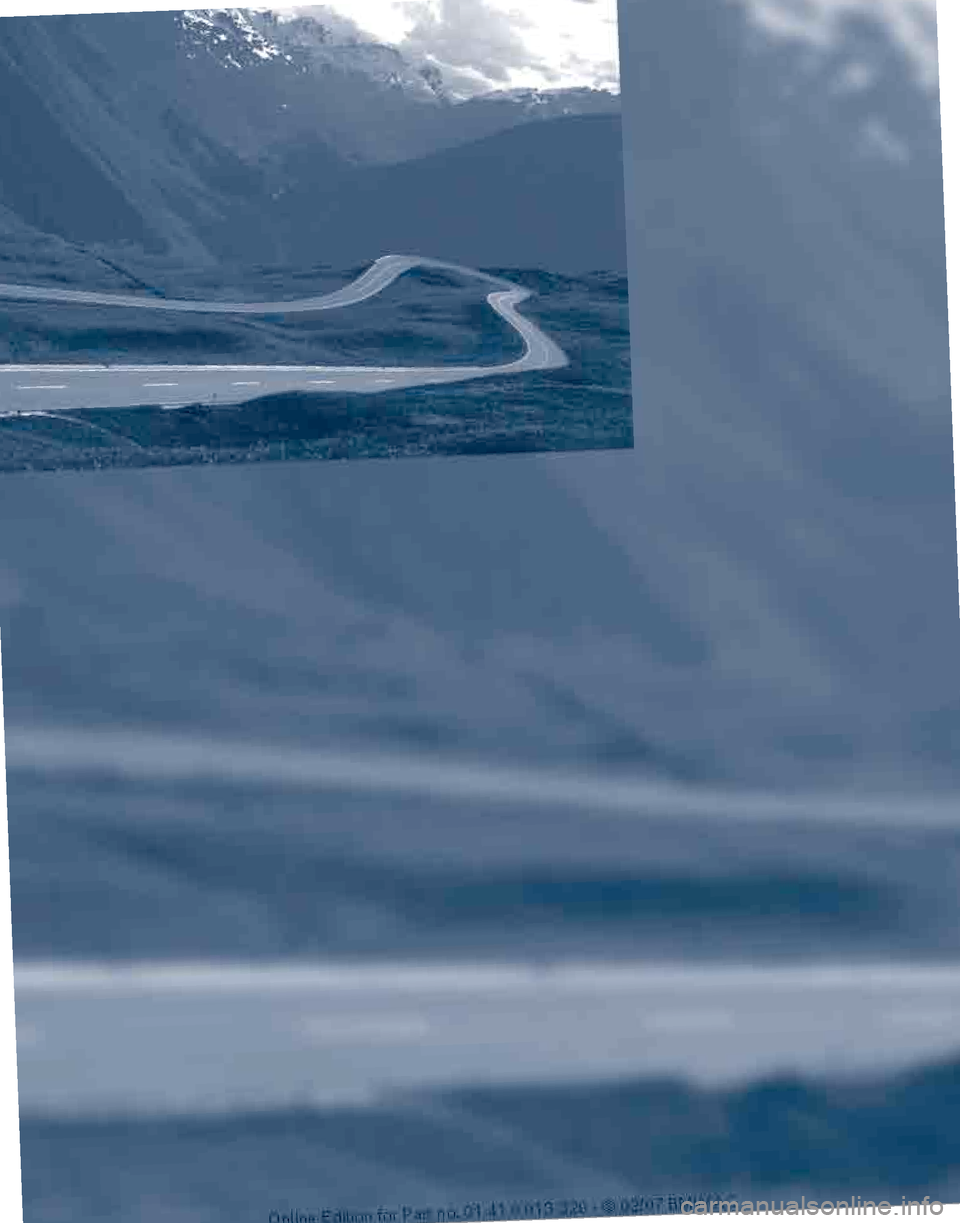
Page 75 of 132
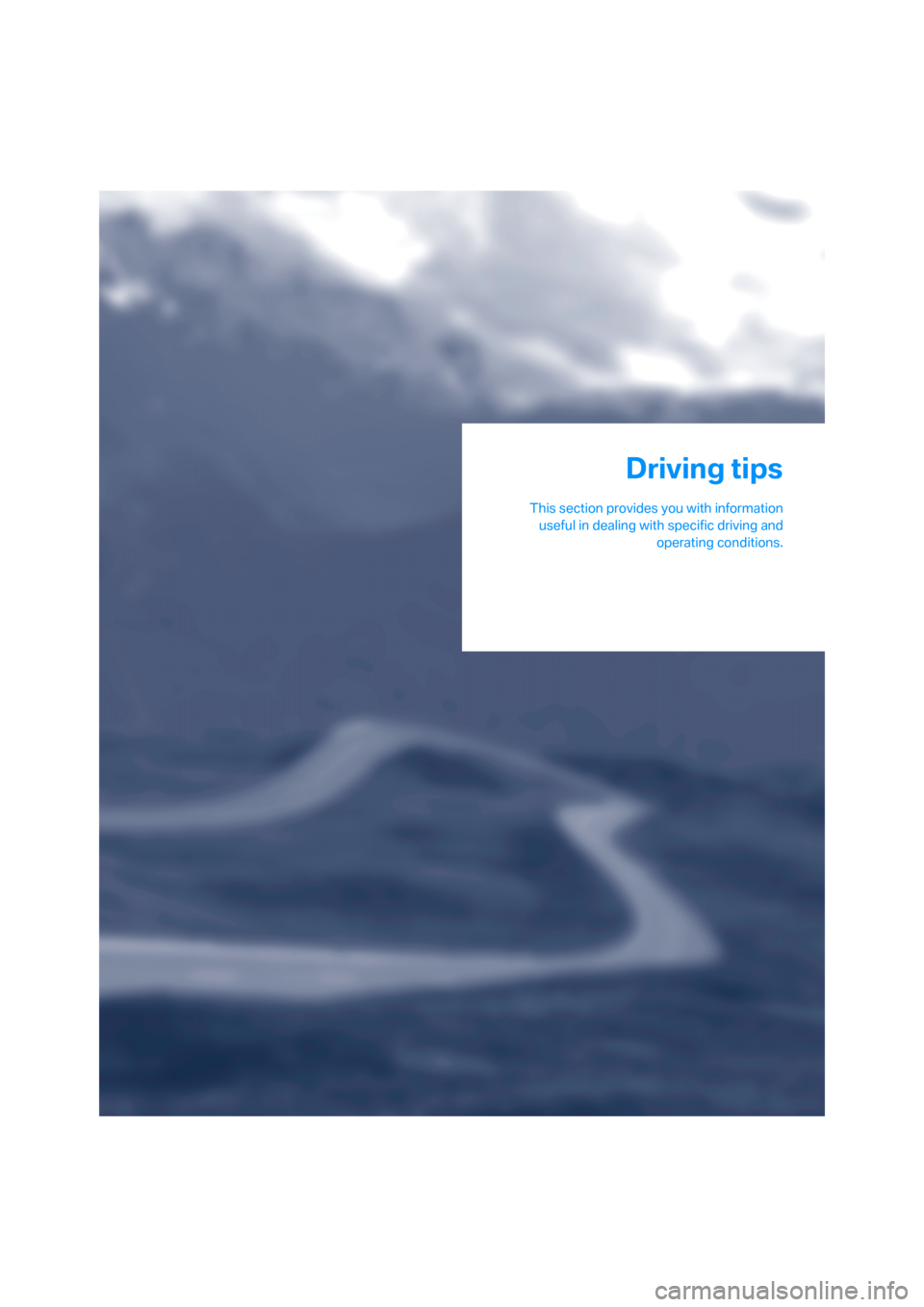
Driving tips
This section provides you with information
useful in dealing with specific driving and
operating conditions.
Driving tips
Page 76 of 132
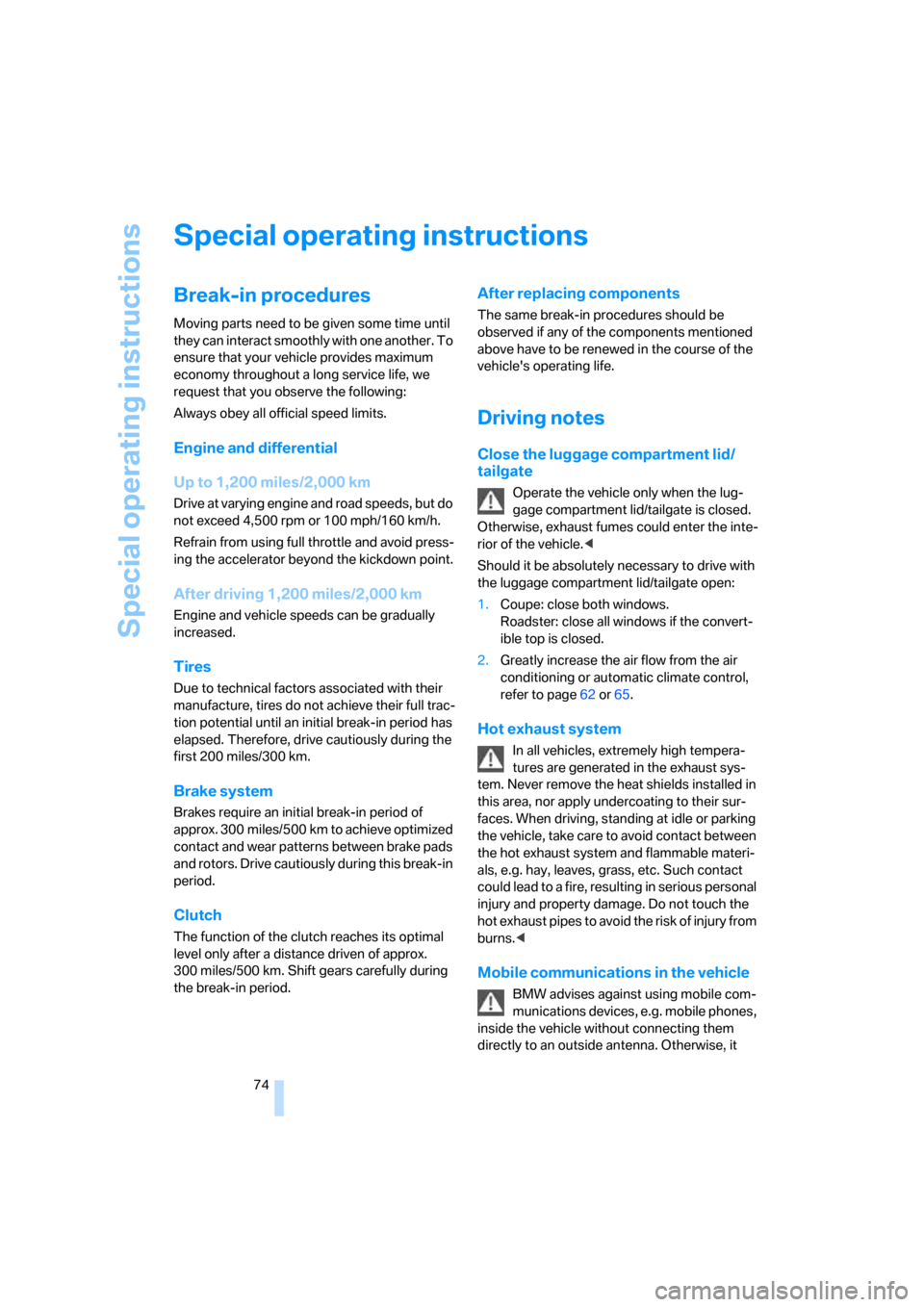
Special operating instructions
74
Special operating instructions
Break-in procedures
Moving parts need to be given some time until
they can interact smoothly with one another. To
ensure that your vehicle provides maximum
economy throughout a long service life, we
request that you observe the following:
Always obey all official speed limits.
Engine and differential
Up to 1,200 miles/2,000 km
Drive at varying engine and road speeds, but do
not exceed 4,500 rpm or 100 mph/160 km/h.
Refrain from using full throttle and avoid press-
ing the accelerator beyond the kickdown point.
After driving 1,200 miles/2,000 km
Engine and vehicle speeds can be gradually
increased.
Tires
Due to technical factors associated with their
manufacture, tires do not achieve their full trac-
tion potential until an initial break-in period has
elapsed. Therefore, drive cautiously during the
first 200 miles/300 km.
Brake system
Brakes require an initial break-in period of
approx. 300 miles/500 km to achieve optimized
contact and wear patterns between brake pads
and rotors. Drive cautiously during this break-in
period.
Clutch
The function of the clutch reaches its optimal
level only after a distance driven of approx.
300 miles/500 km. Shift gears carefully during
the break-in period.
After replacing components
The same break-in procedures should be
observed if any of the components mentioned
above have to be renewed in the course of the
vehicle's operating life.
Driving notes
Close the luggage compartment lid/
tailgate
Operate the vehicle only when the lug-
gage compartment lid/tailgate is closed.
Otherwise, exhaust fumes could enter the inte-
rior of the vehicle.<
Should it be absolutely necessary to drive with
the luggage compartment lid/tailgate open:
1.Coupe: close both windows.
Roadster: close all windows if the convert-
ible top is closed.
2.Greatly increase the air flow from the air
conditioning or automatic climate control,
refer to page62 or65.
Hot exhaust system
In all vehicles, extremely high tempera-
tures are generated in the exhaust sys-
tem. Never remove the heat shields installed in
this area, nor apply undercoating to their sur-
faces. When driving, standing at idle or parking
the vehicle, take care to avoid contact between
the hot exhaust system and flammable materi-
als, e.g. hay, leaves, grass, etc. Such contact
could lead to a fire, resulting in serious personal
injury and property damage. Do not touch the
hot exhaust pipes to avoid the risk of injury from
burns.<
Mobile communications in the vehicle
BMW advises against using mobile com-
munications devices, e.g. mobile phones,
inside the vehicle without connecting them
directly to an outside antenna. Otherwise, it
Page 77 of 132
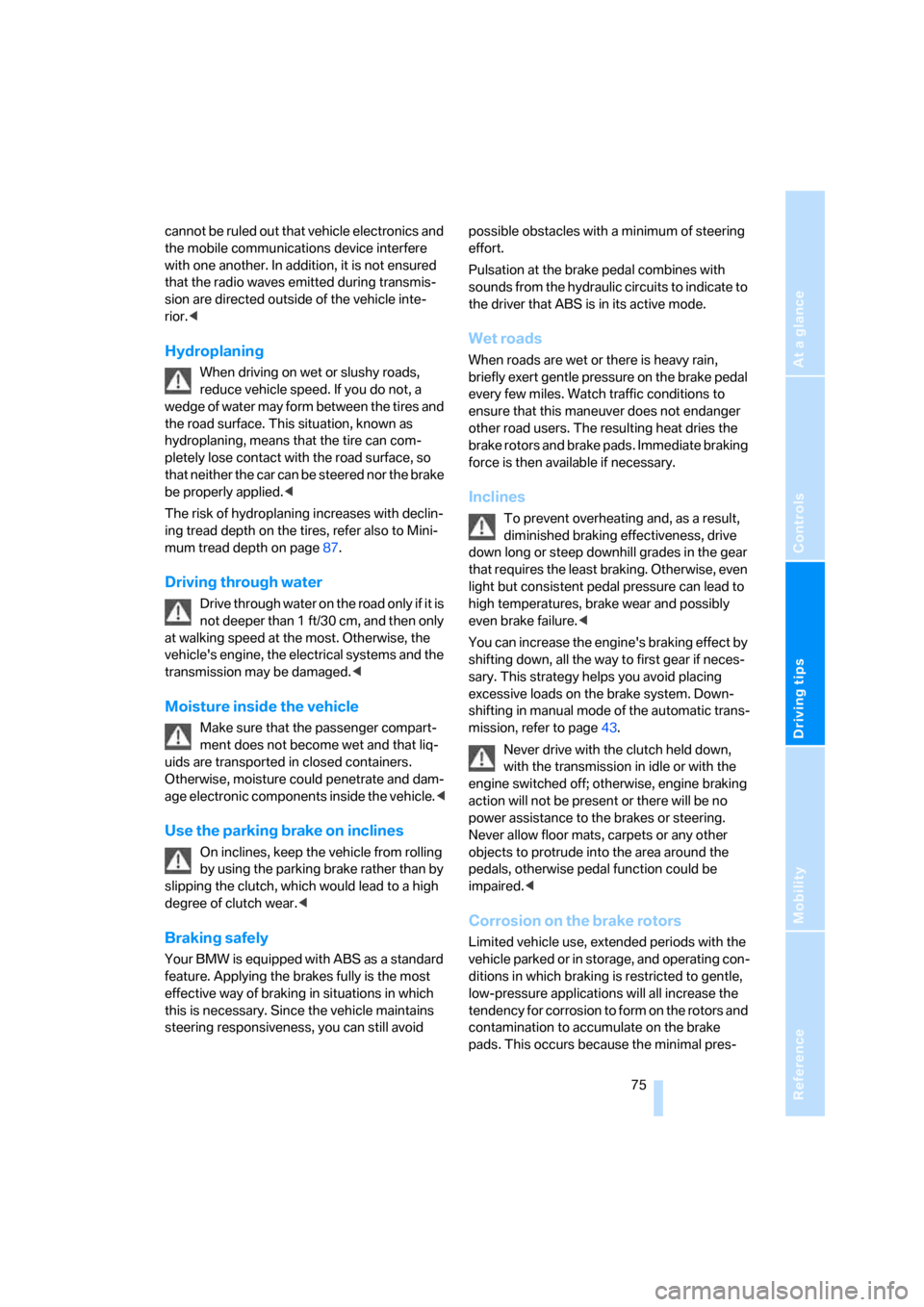
Reference
At a glance
Controls
Driving tips
Mobility
75
cannot be ruled out that vehicle electronics and
the mobile communications device interfere
with one another. In addition, it is not ensured
that the radio waves emitted during transmis-
sion are directed outside of the vehicle inte-
rior.<
Hydroplaning
When driving on wet or slushy roads,
reduce vehicle speed. If you do not, a
wedge of water may form between the tires and
the road surface. This situation, known as
hydroplaning, means that the tire can com-
pletely lose contact with the road surface, so
that neither the car can be steered nor the brake
be properly applied.<
The risk of hydroplaning increases with declin-
ing tread depth on the tires, refer also to Mini-
mum tread depth on page87.
Driving through water
Drive through water on the road only if it is
not deeper than 1 ft/30 cm, and then only
at walking speed at the most. Otherwise, the
vehicle's engine, the electrical systems and the
transmission may be damaged.<
Moisture inside the vehicle
Make sure that the passenger compart-
ment does not become wet and that liq-
uids are transported in closed containers.
Otherwise, moisture could penetrate and dam-
age electronic components inside the vehicle.<
Use the parking brake on inclines
On inclines, keep the vehicle from rolling
by using the parking brake rather than by
slipping the clutch, which would lead to a high
degree of clutch wear.<
Braking safely
Your BMW is equipped with ABS as a standard
feature. Applying the brakes fully is the most
effective way of braking in situations in which
this is necessary. Since the vehicle maintains
steering responsiveness, you can still avoid possible obstacles with a minimum of steering
effort.
Pulsation at the brake pedal combines with
sounds from the hydraulic circuits to indicate to
the driver that ABS is in its active mode.
Wet roads
When roads are wet or there is heavy rain,
briefly exert gentle pressure on the brake pedal
every few miles. Watch traffic conditions to
ensure that this maneuver does not endanger
other road users. The resulting heat dries the
brake rotors and brake pads. Immediate braking
force is then available if necessary.
Inclines
To prevent overheating and, as a result,
diminished braking effectiveness, drive
down long or steep downhill grades in the gear
that requires the least braking. Otherwise, even
light but consistent pedal pressure can lead to
high temperatures, brake wear and possibly
even brake failure.<
You can increase the engine's braking effect by
shifting down, all the way to first gear if neces-
sary. This strategy helps you avoid placing
excessive loads on the brake system. Down-
shifting in manual mode of the automatic trans-
mission, refer to page43.
Never drive with the clutch held down,
with the transmission in idle or with the
engine switched off; otherwise, engine braking
action will not be present or there will be no
power assistance to the brakes or steering.
Never allow floor mats, carpets or any other
objects to protrude into the area around the
pedals, otherwise pedal function could be
impaired.<
Corrosion on the brake rotors
Limited vehicle use, extended periods with the
vehicle parked or in storage, and operating con-
ditions in which braking is restricted to gentle,
low-pressure applications will all increase the
tendency for corrosion to form on the rotors and
contamination to accumulate on the brake
pads. This occurs because the minimal pres-
Page 78 of 132
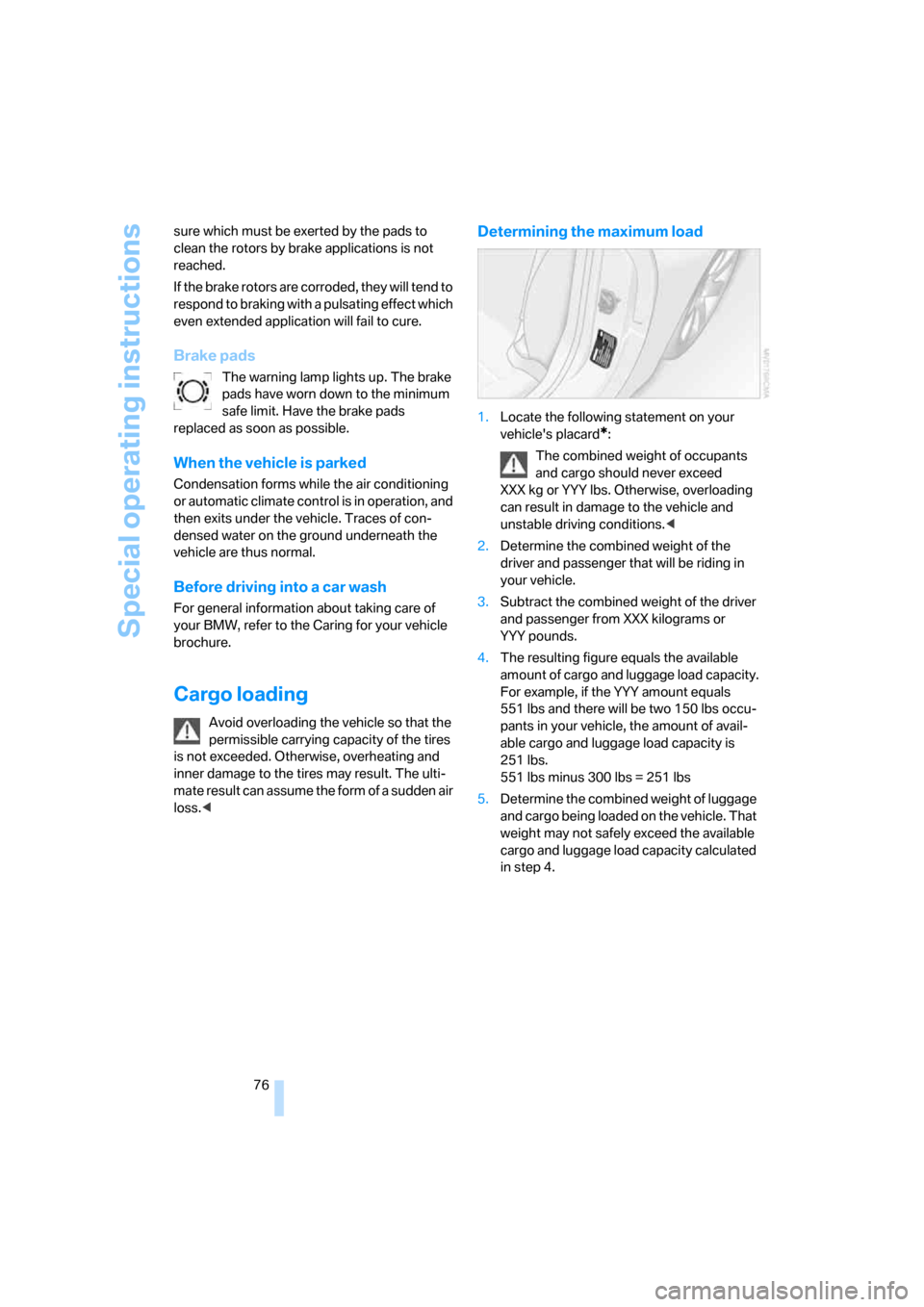
Special operating instructions
76 sure which must be exerted by the pads to
clean the rotors by brake applications is not
reached.
If the brake rotors are corroded, they will tend to
respond to braking with a pulsating effect which
even extended application will fail to cure.
Brake pads
The warning lamp lights up. The brake
pads have worn down to the minimum
safe limit. Have the brake pads
replaced as soon as possible.
When the vehicle is parked
Condensation forms while the air conditioning
or automatic climate control is in operation, and
then exits under the vehicle. Traces of con-
densed water on the ground underneath the
vehicle are thus normal.
Before driving into a car wash
For general information about taking care of
your BMW, refer to the Caring for your vehicle
brochure.
Cargo loading
Avoid overloading the vehicle so that the
permissible carrying capacity of the tires
is not exceeded. Otherwise, overheating and
inner damage to the tires may result. The ulti-
mate result can assume the form of a sudden air
loss.<
Determining the maximum load
1.Locate the following statement on your
vehicle's placard
*:
The combined weight of occupants
and cargo should never exceed
XXX kg or YYY lbs. Otherwise, overloading
can result in damage to the vehicle and
unstable driving conditions.<
2.Determine the combined weight of the
driver and passenger that will be riding in
your vehicle.
3.Subtract the combined weight of the driver
and passenger from XXX kilograms or
YYY pounds.
4.The resulting figure equals the available
amount of cargo and luggage load capacity.
For example, if the YYY amount equals
551 lbs and there will be two 150 lbs occu-
pants in your vehicle, the amount of avail-
able cargo and luggage load capacity is
251 lbs.
551 lbs minus 300 lbs = 251 lbs
5.Determine the combined weight of luggage
and cargo being loaded on the vehicle. That
weight may not safely exceed the available
cargo and luggage load capacity calculated
in step 4.
Page 79 of 132
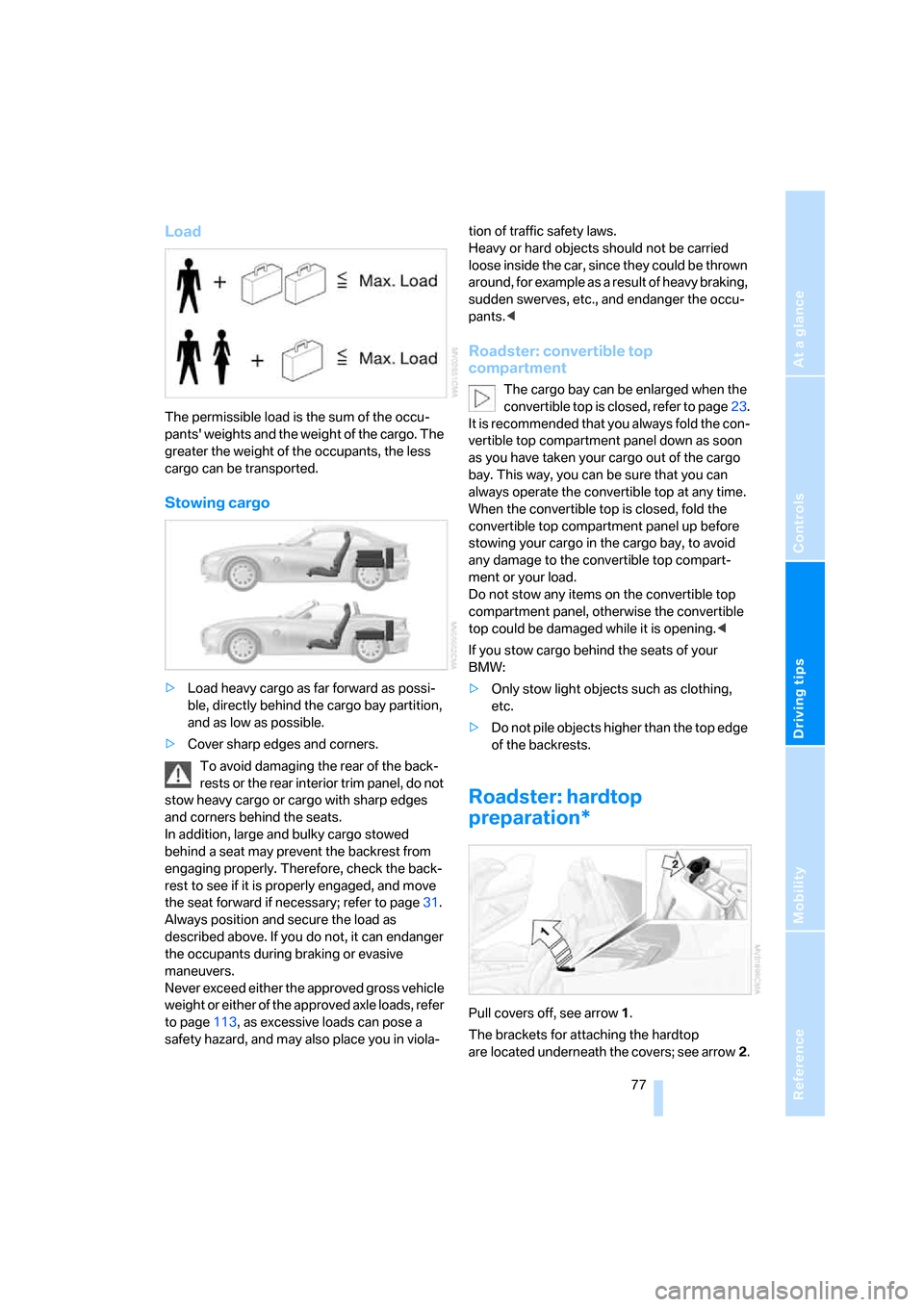
Reference
At a glance
Controls
Driving tips
Mobility
77
Load
The permissible load is the sum of the occu-
pants' weights and the weight of the cargo. The
greater the weight of the occupants, the less
cargo can be transported.
Stowing cargo
>Load heavy cargo as far forward as possi-
ble, directly behind the cargo bay partition,
and as low as possible.
>Cover sharp edges and corners.
To avoid damaging the rear of the back-
rests or the rear interior trim panel, do not
stow heavy cargo or cargo with sharp edges
and corners behind the seats.
In addition, large and bulky cargo stowed
behind a seat may prevent the backrest from
engaging properly. Therefore, check the back-
rest to see if it is properly engaged, and move
the seat forward if necessary; refer to page31.
Always position and secure the load as
described above. If you do not, it can endanger
the occupants during braking or evasive
maneuvers.
Never exceed either the approved gross vehicle
weight or either of the approved axle loads, refer
to page113, as excessive loads can pose a
safety hazard, and may also place you in viola-tion of traffic safety laws.
Heavy or hard objects should not be carried
loose inside the car, since they could be thrown
around, for example as a result of heavy braking,
sudden swerves, etc., and endanger the occu-
pants.<
Roadster: convertible top
compartment
The cargo bay can be enlarged when the
convertible top is closed, refer to page23.
I t i s r e c o m m e n d ed t h a t y o u a lw a y s f o l d t h e c o n -
vertible top compartment panel down as soon
as you have taken your cargo out of the cargo
bay. This way, you can be sure that you can
always operate the convertible top at any time.
When the convertible top is closed, fold the
convertible top compartment panel up before
stowing your cargo in the cargo bay, to avoid
any damage to the convertible top compart-
ment or your load.
Do not stow any items on the convertible top
compartment panel, otherwise the convertible
top could be damaged while it is opening.<
If you stow cargo behind the seats of your
BMW:
>Only stow light objects such as clothing,
etc.
>Do not pile objects higher than the top edge
of the backrests.
Roadster: hardtop
preparation*
Pull covers off, see arrow1.
The brackets for attaching the hardtop
are located underneath the covers; see arrow2.
Page 80 of 132

Special operating instructions
78 For instructions on how to install the
hardtop, please read the accompanying
assembly information.
The hardtop is available from your BMW center
as an optional extra.<